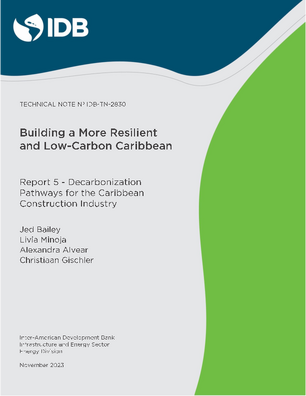Building a More Resilient and Low-Carbon Caribbean: Report 5: Decarbonization Pathways for the Caribbean Construction Industry
Date
Nov 2023
The Caribbean islands are among the 25 most-vulnerable nations in terms of disasters per-capita or land area, and climate change is only expected to intensify these vulnerabilities. Within this context, the series “Building a more resilient and low-carbon Caribbean”, focuses on improving the resiliency, sustainability and decarbonization of the construction industry in the Caribbean.
The first three reports of the series analyze the economic losses caused by climate related events, the benefits of improving building resiliency to reduce those economic losses and the benefits of subsidized financing for resilient buildings in the Caribbean, showing that increasing building resiliency is economically viable for the high-risk islands of the Caribbean, generating long term savings and increasing the infrastructure preparedness to the impacts of CC. The fourth report focused on the potential role for nature-based solutions (NBSs) in the region. This report extends the previous analysis to examine potential options to reduce embodied carbon in traditional resilient building materials such as cement and steel in the region.
The first three reports of the series analyze the economic losses caused by climate related events, the benefits of improving building resiliency to reduce those economic losses and the benefits of subsidized financing for resilient buildings in the Caribbean, showing that increasing building resiliency is economically viable for the high-risk islands of the Caribbean, generating long term savings and increasing the infrastructure preparedness to the impacts of CC. The fourth report focused on the potential role for nature-based solutions (NBSs) in the region. This report extends the previous analysis to examine potential options to reduce embodied carbon in traditional resilient building materials such as cement and steel in the region.




